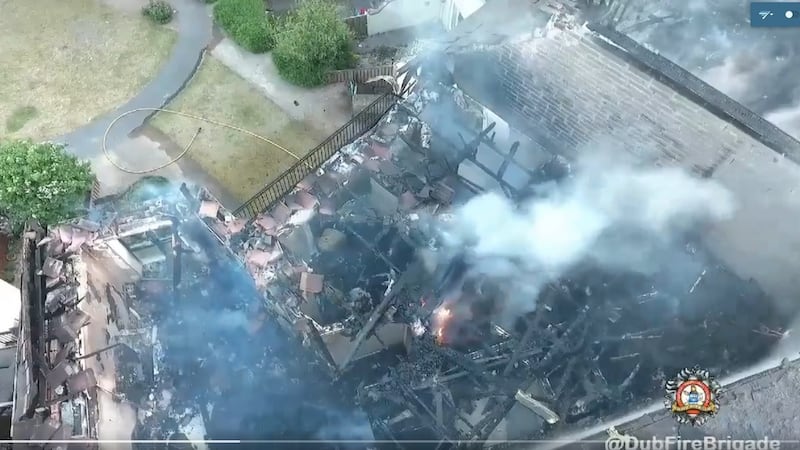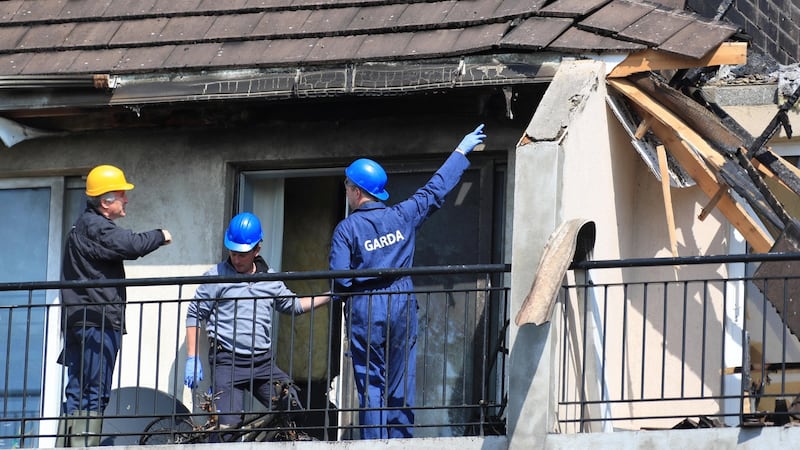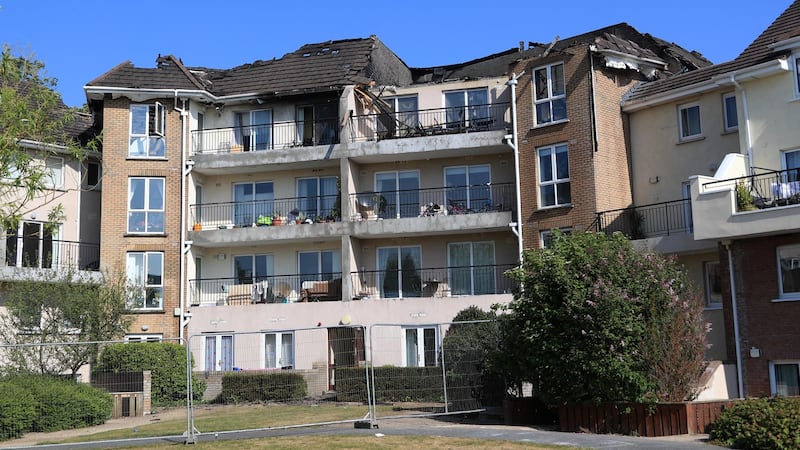“I picked up the phone and all I could hear was the sound of a female screaming in the background.
“The female voice was screaming ‘my baby, my baby’.”
Those were the last words Louise Wall (21) spoke on the night she and her partner Michael Farrell (23) died in an apartment fire in Blanchardstown, Dublin 15, on March 18th, 2002.
She was calling out for her three-year-old son, Dylan, who was staying nearby at her mother’s home that night.
READ MORE
The young couple had just moved into the 274-unit Verdemont complex, which was built only a year previously by McInerney Construction.
The apartment was large and spacious and barely lived in – but there were serious defects lying underneath the fresh paint and shining exterior.
The issue of fire-safety defects has been brought to light in recent years, with a Government working group estimating the total number of homes across the country affected by such issues at up to 100,000 units.
In January 2023, Cabinet approved plans to fund the repair of up to 100,000 defective apartments or duplexes at a cost of up to €2.5 billion to the State.
While Government prepares legislation to put that scheme on a statutory footing, an interim fund was opened in December to finance emergency works.
However, as reported by The Irish Times last week, that interim funding scheme has also hit a roadblock, with no applicants receiving any funding so far.
While further delays frustrate the process of remediating Ireland’s defective Celtic Tiger builds, it is worth recalling the real danger present in so many homes across the State.
The first evidence of construction defects at Verdemont was heard at the inquest into Wall and Farrell’s deaths, which detailed bricked-up air vents, a lack of ventilation and an absence of fire alarms.
The jury raised concerns over the fire-safety compliance of the complex and the quality of the workmanship in building it.
It would take another 15 years for anything to actually be done about it, at which point the builder was gone into liquidation and the owners had no way of pursuing McInerney through the courts.
In 2017, a second serious blaze took hold at an apartment in the Green Briar block at Verdemont, ripping through multiple roofs and revealing a litany of fire-safety defects throughout the development.
Dramatic footage shared online showed a smouldering roof cavity and blackened balconies.

Although there were no injuries or deaths this time, it was clear the problem could not be ignored and investigative works found there was little to stop a fire rapidly spreading through lift shafts, waste pipes, attics, doors, hallways and individual apartments. It was potentially a very dangerous place to live.
The Fire Safety Certificate granted for the development stipulates extensive fire-stopping measures should be put in place at the time of construction to mitigate the risk of a fire spreading throughout the block.
None of these measures were installed in Verdemont, and because the developer went into liquidation in 2010, owners could not pursue the company through the courts.
The Dublin City Chief Fire Officer insisted on a 24-hour fire warden to patrol the site, while the owners’ management company (OMC) scrambled to come up with a plan to remediate the defects.
In the years since the 2017 fire, a significant amount of work has been completed at Verdemont.
Fire-stopping measures have largely been completed in all common areas and between the walls and roofs of the six main blocks, at a cost of €2,000 to each owner.
However, the most expensive and by far the most extensive remediation work has yet to begin.

That final phase will involve remediating the individual apartments to bring them up to fire safety standards, and has been estimated to cost up to €4 million in total, or about €15,000 per apartment.
Work on this final phase has stalled amid uncertainty about a Government-funded remediation scheme, meaning fire could still spread more quickly than it should within individual apartments.
Karen McAffee is the owner of an apartment at Verdemont in which her father currently lives, and is also a member of the current OMC at the complex.
Although she is happy that work is progressing at the complex, and they are aware of all the issues; in working through remediating them, the State scheme will be key to them finishing out the works.
“I don’t think the State is moving fast enough on these issues,” McAffee says, speaking in a personal capacity and not on behalf of the OMC.
“We have known these issues are out there for years, there are places way worse than Verdemont where people have had to physically move out because they have been told ‘you simply can’t live here, it’s not safe’. So from that, it’s moving ridiculously slowly.”
She is assured by the precedent set in the pyrite and mica remediation schemes, and by the fact the complex has always been able to secure insurance.
“I feel that we’re beginning to see that there is light at the end of the end of the tunnel,” McAffee says.
As Verdemont now edges closer to full remediation, pending a State scheme, the fatal fire of St Patrick’s weekend in 2002 has continued to devastate Louise Wall’s family.
Shane Wall, who found the bodies of his sister Louise and Michael at Verdemont that day, died by suicide two years later.
“We didn’t just lose Louise, we lost Shane. Shane couldn’t live with it, and he took his own life. So we lost two that day.,” says Louise’s mother, Margaret Brady.

Louise was a “very quiet, happy and smiley person” who had done well in school and continued to work hard after the birth of her son at the age of 17, her mother remembers.
She was a “natural” mother, nurturing and loving, and “adored” her son, with whom she had a “beautiful relationship”, recalls her sister, Gillian Wall.
“Louise was very quiet, but she was very funny,” Gillian says.
As a sister, she was “perfect”.
“You don’t say that about anybody, but Louise was. There was never trouble, never drama. She never fought and she was quite angelic in her own right. She was regal, even though she was quite young. There was something very special about our Louise,” Gillian says.
There were 11 months between Shane and Louise, and they were “best friends”.
“Now they’re dead. Their lives are gone … I’m so bitter over it,” Margaret says.
Both Margaret and Gillian feel they have no closure, and cannot get on with their lives with any peace of mind in the absence of any accountability from the builder or the State.
“There’s no answers, there’s no remorse, no apology. The thing that’s very frustrating is that the last time [in 2017] more people could have been killed. Do lives not matter anymore? These people were given this house on the grounds that it’s safe. But it wasn’t a home – it killed them.
“It makes me very angry,” Gillian says.
While Margaret and Gillian mourn, a State remediation scheme trudges through a legal system and apartment owners across the country are scrambling to get the money together to fix defects that should never have existed if building regulations were complied with.
A spokeswoman for the Department of Housing said the legislation underpinning the €2.5 billion State scheme was “progressing as a matter of priority” and that draft legislation was expected to be published “in the coming months and following its passage the statutory scheme will be in place shortly thereafter”.
“Given the complexity of the issues, including the significant amount of exchequer funding that this Government has committed to assist affected homeowners (between €1.5 billion and €2.5 billion), sufficient time is required to ensure that the scheme is fit for purpose, provides value for tax payers’ money and contains appropriate oversight and governance measures,” the spokeswoman said.
A comment has been sought from the OMC and the liquidator for McInerney Construction.
- Sign up for push alerts and have the best news, analysis and comment delivered directly to your phone
- Join The Irish Times on WhatsApp and stay up to date
- Listen to our Inside Politics podcast for the best political chat and analysis












